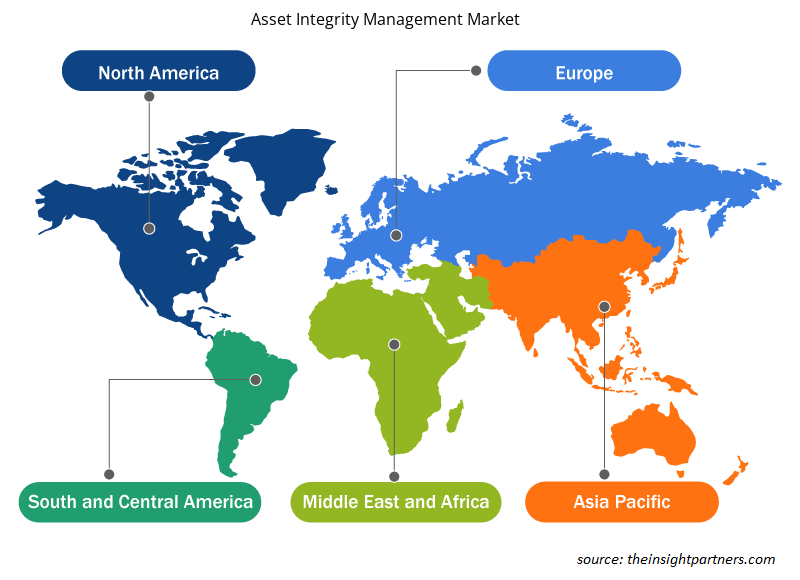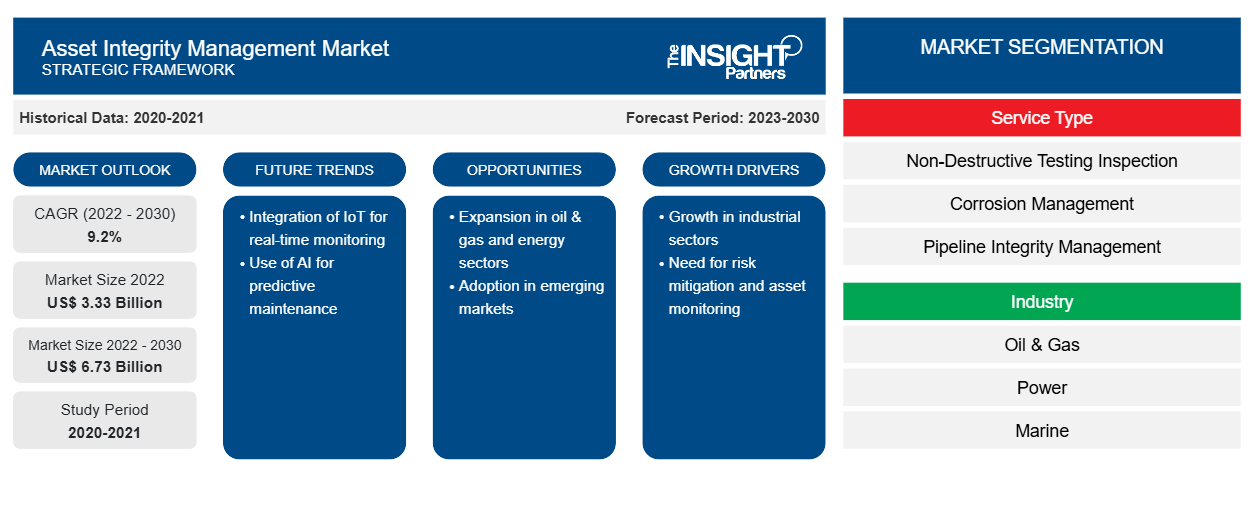[研究报告] 2022 年资产完整性管理市场价值为 33.3 亿美元,预计到 2030 年将达到 67.3 亿美元;预计 2022 年至 2030 年的复合年增长率为 9.2%。资产完整性管理市场趋势包括 IIoT 与资产完整性管理解决方案的集成。
分析师观点:
资产完整性管理市场预测 可以帮助该市场的利益相关者规划其增长战略。资产完整性管理系统与任何资产活动(如治理和监控)相关联,以保持公司的成功运营,同时最大限度地降低危险和风险。风险型行业对老化资产运营安全的需求不断增加,推动了资产完整性管理市场的发展。
石油和天然气、采矿和电力行业资产的运营效率被视为重中之重;因此,定期维护这些资产对于实现最大生产力至关重要。化学品和石油和天然气产品具有腐蚀性和易燃性,因此需要不断检查和维护设备以确保整体运营效率和安全性。此外,随着石油和天然气需求的增加以及多个国家电力行业的增长,石油和天然气行业的扩张预计将在预测期内为资产完整性管理市场增长创造许多机会。
随着各行各业数字化转型的兴起,石油和天然气行业在全球工业革命和经济增长中发挥着关键作用。推动该行业发展的主要因素是人口快速增长导致对电力、动力、汽车和飞机的需求旺盛。由于现有石油储量的枯竭,全球石油供应预计将迅速增加,以满足能源需求的增长。根据国际能源署 (IEA) 的数据,截至 2023 年 6 月,由于石化和航空业的巨大需求,全球石油需求预计将在 2022 年至 2028 年间增长 6%,达到 1.057 亿桶/天 (mb/d)。因此,石化和航空业对石油和天然气的需求增加也推动了石油和天然气行业的发展,促进了资产完整性管理市场份额的扩大。
定制此报告以满足您的需求
您可以免费定制任何报告,包括本报告的部分内容、国家级分析、Excel 数据包,以及为初创企业和大学提供优惠和折扣
- 获取此报告的关键市场趋势。这个免费样品将包括数据分析,从市场趋势到估计和预测。
资产完整性管理市场概述:
资产完整性管理是一种资产管理标准,侧重于保护设备、健康和环境。它有效且高效地维持资产的持续运转,并具有多种优势,包括降低风险和提高可靠性、提高安全性和改善环境性能。它通常用于石油和天然气、采矿、航空航天和其他行业。
资产完整性管理市场预计将在未来几年实现增长。这归因于多种因素,包括风险行业对老化资产运营安全的需求增加以及政府主导的严格安全法规。此外,石油和天然气行业的扩张以及对石油和天然气的需求增加预计将在未来几年为市场参与者创造增长机会。然而,非增值维护和资产不当操作所涉及的成本阻碍了资产完整性管理市场的增长。
资产完整性管理市场驱动因素:
风险型行业对老化资产运营安全的需求增加
资产完整性管理软件可保护资产有效执行其功能的能力,并管理公司资产以获得盈利能力。资产完整性管理软件提供各种服务,包括设计、检查、维护和运营,这些服务对基础设施和设备的完整性影响很大。它还提供审计、检查、整体质量流程和其他工具,以有效地管理资产的完整性。石化、石油和天然气、可再生能源、电力和基础设施等行业选择这些服务来提高生产力,同时满足环境和安全问题。这些行业基于风险,高度依赖资产;因此,这些资产的维护和检查至关重要。在石油和天然气行业,性能和运营风险水平取决于整个价值链中资产的完整性,例如海底设备、平台上部、结构、天然气加工厂、管道、炼油厂、压缩机和天然气分配网络。在石油和天然气、采矿和电力行业中,资产的运营效率非常必要;因此,定期维护这些资产对于获得最大生产力非常重要。因此,借助资产完整性管理解决方案实现运营安全的必要性正在推动资产完整性管理市场的发展。
化学品和石油天然气产品具有腐蚀性和易燃性,需要对设备进行持续检查和维护,以确保整体运行效率和安全性。资产完整性管理服务可确保提高设备的可靠性、生产力和安全性,从而可持续地实现高质量性能。全球各地的各种市场参与者都在提供资产完整性管理软件来管理性能和运营风险。例如,DNV Group AS 提供 Synergi 资产完整性软件套件,该套件提供了一个核心平台,以支持石油和天然气等风险型行业中有效的基于风险的完整性管理。因此,风险型行业对老化资产的运营安全的需求是资产完整性管理市场规模不断增长的因素之一。
细分分析:
资产完整性管理市场分为服务类型和行业。根据服务类型,市场细分为无损检测 (NDT) 检查、腐蚀管理、管道完整性管理、结构完整性管理、基于风险的检查 (RBI) 等。根据行业,市场细分为石油和天然气、电力、海洋、采矿、航空航天等。
区域分析:
资产完整性管理市场报告包括北美、欧洲、亚太地区、中东和非洲以及南美和中美洲。就收入而言,北美占据了资产完整性管理市场份额的主导地位。北美资产完整性管理市场分为美国、加拿大和墨西哥。过去几年,这三个国家都见证了资产完整性管理服务的采用率不断提高。石油和天然气、化工、电力和自然资源行业依靠专有基础设施来运营,而这些基础设施正在迅速老化,这增加了发生故障的风险。
在石油和天然气行业,大多数成熟油田的基础设施都比较陈旧,这会导致腐蚀、结垢和井设备损坏,并引发其他井完整性问题。这些问题增加了公司和公用事业的运营风险,需要在基础设施升级项目中投入更多资金。北美的石油和天然气行业需要遵守多项政府政策和法规,以保护环境、保护文化资源并保护工人的健康和安全。该地区的上游和中游基础设施非常庞大。
美国是最大的石油和天然气生产国,涉及勘探、炼油和运输活动。此外,在美国,钻井工人增加了新的石油钻井平台,使石油钻井平台总数达到 862 个。美国拥有超过 250 万公里的石油和天然气管道,而加拿大拥有约 80 万公里的管道。由于其庞大且老化的基础设施,北美很可能在预测期内主导市场。此外,美国拥有世界上最古老的发电系统。美国是世界领先的能源生产国,水力压裂和水平钻井是帮助该国增加能源产量的技术。因此,严格的政府法规和庞大的天然气管道网络的存在预计将为各个行业增加资产完整性管理的采用创造机会,这可能会推动北美资产完整性管理市场的增长。
关键球员分析:
资产完整性管理市场分析基于 SGS AG、Intertek Group plc、Aker Solutions ASA、Bureau Veritas SA、Fluor Corporation、DNV GL AS、John Wood Group PLC、Oceaneering International, Inc.、Rosen Group 和 Cybernetix SA 等主要参与者的年度业绩。分析了其他几家重要的资产完整性管理市场参与者,以全面了解市场及其生态系统。资产完整性管理市场报告强调了推动市场发展的关键因素和知名参与者的发展。
资产完整性管理市场区域洞察
Insight Partners 的分析师已详尽解释了预测期内影响资产完整性管理市场的区域趋势和因素。本节还讨论了资产完整性管理市场的各个部分和地理位置,包括北美、欧洲、亚太地区、中东和非洲以及南美和中美洲。

- 获取资产完整性管理市场的区域特定数据
资产完整性管理市场报告范围
| 报告属性 | 细节 |
|---|---|
| 2022 年市场规模 | 33.3亿美元 |
| 2030 年的市场规模 | 67.3亿美元 |
| 全球复合年增长率(2022 - 2030 年) | 9.2% |
| 史料 | 2020-2021 |
| 预测期 | 2023-2030 |
| 涵盖的领域 | 按服务类型
|
| 覆盖地区和国家 | 北美
|
| 市场领导者和主要公司简介 |
|
资产完整性管理市场参与者密度:了解其对业务动态的影响
资产完整性管理市场正在快速增长,这得益于终端用户需求的不断增长,而这些需求又源于消费者偏好的不断变化、技术进步以及对产品优势的认识不断提高等因素。随着需求的增加,企业正在扩大其产品范围,进行创新以满足消费者的需求,并利用新兴趋势,从而进一步推动市场增长。
市场参与者密度是指在特定市场或行业内运营的企业或公司的分布情况。它表明在给定市场空间中,相对于其规模或总市场价值,有多少竞争对手(市场参与者)存在。
在资产完整性管理市场运营的主要公司有:
- 瑞士通用公证行
- 天祥集团
- 阿克尔解决方案公司
- 法国船级社
- 福陆公司
免责声明:上面列出的公司没有按照任何特定顺序排列。

- 获取资产完整性管理市场顶级关键参与者概览
最新动态:
资产完整性管理市场中的公司专注于无机和有机战略来促进业务增长。以下列出了上述资产完整性管理市场参与者的一些近期关键市场发展:
- 2023年5月,SGS参加了在阿联酋阿布扎比举办的中东资产完整性管理会议及展览会(AIMCS)。此次活动由阿布扎比国家石油公司天然气处理部门担任技术主席,邀请了300多位行业专家和专业人士共同探讨资产完整性管理的最新趋势和最佳实践。
- 2021 年 3 月,福陆公司旗下的 Stork 获得了 Chrysaor Holdings Limited 为期两年的合同续约,将在英国提供海上综合专业资产完整性服务。该公司将继续通过这份合同为北海中部的 Armada、Everest 和 Lomond 平台提供全面的资产管理解决方案和能力,以延长海上资产的生命周期。
- 历史分析(2 年)、基准年、预测(7 年)及复合年增长率
- PEST 和 SWOT 分析
- 市场规模价值/数量 - 全球、区域、国家
- 行业和竞争格局
- Excel 数据集



Report Coverage
Revenue forecast, Company Analysis, Industry landscape, Growth factors, and Trends

Segment Covered
This text is related
to segments covered.

Regional Scope
North America, Europe, Asia Pacific, Middle East & Africa, South & Central America

Country Scope
This text is related
to country scope.
常见问题
The non-destructive testing (NDT) inspection segment led the asset integrity management market with a significant share in 2022 and corrosion management segment is expected to grow with the highest CAGR.
Increase in need for operational safety of aging assets in risk-based industries and stringent government safety regulations are driving factors of asset integrity management market.
The asset integrity management market was estimated to be valued at US$ 3.33 billion in 2022 and is projected to reach US$ 6.73 billion by 2030; it is expected to grow at a CAGR of 9.2% during the forecast period.
APAC is anticipated to grow with the highest CAGR over the forecast period.
The key players holding majority shares in the asset integrity management market include Fluor Corporation, Aker Solutions, Intertek Group plc, John Wood Group PLC, and Bureau Veritas.
The integration of digital twin and IIoT with asset integrity management software is expected to drive the growth of the asset integrity management market in the coming years.
The asset integrity management market is expected to reach US$ 6.73 billion by 2030.
Trends and growth analysis reports related to Technology, Media and Telecommunications : READ MORE..
The List of Companies - Asset Integrity Management Market
- SGS SA
- Intertek Group Plc
- Aker Solutions ASA
- Bureau Veritas SA
- Fluor Corp
- DNV Group AS
- John Wood Group Plc
- ROSEN Group
- TechnipFMC plc
- Oceaneering International Inc
The Insight Partners performs research in 4 major stages: Data Collection & Secondary Research, Primary Research, Data Analysis and Data Triangulation & Final Review.
- Data Collection and Secondary Research:
As a market research and consulting firm operating from a decade, we have published and advised several client across the globe. First step for any study will start with an assessment of currently available data and insights from existing reports. Further, historical and current market information is collected from Investor Presentations, Annual Reports, SEC Filings, etc., and other information related to company’s performance and market positioning are gathered from Paid Databases (Factiva, Hoovers, and Reuters) and various other publications available in public domain.
Several associations trade associates, technical forums, institutes, societies and organization are accessed to gain technical as well as market related insights through their publications such as research papers, blogs and press releases related to the studies are referred to get cues about the market. Further, white papers, journals, magazines, and other news articles published in last 3 years are scrutinized and analyzed to understand the current market trends.
- Primary Research:
The primarily interview analysis comprise of data obtained from industry participants interview and answers to survey questions gathered by in-house primary team.
For primary research, interviews are conducted with industry experts/CEOs/Marketing Managers/VPs/Subject Matter Experts from both demand and supply side to get a 360-degree view of the market. The primary team conducts several interviews based on the complexity of the markets to understand the various market trends and dynamics which makes research more credible and precise.
A typical research interview fulfils the following functions:
- Provides first-hand information on the market size, market trends, growth trends, competitive landscape, and outlook
- Validates and strengthens in-house secondary research findings
- Develops the analysis team’s expertise and market understanding
Primary research involves email interactions and telephone interviews for each market, category, segment, and sub-segment across geographies. The participants who typically take part in such a process include, but are not limited to:
- Industry participants: VPs, business development managers, market intelligence managers and national sales managers
- Outside experts: Valuation experts, research analysts and key opinion leaders specializing in the electronics and semiconductor industry.
Below is the breakup of our primary respondents by company, designation, and region:

Once we receive the confirmation from primary research sources or primary respondents, we finalize the base year market estimation and forecast the data as per the macroeconomic and microeconomic factors assessed during data collection.
- Data Analysis:
Once data is validated through both secondary as well as primary respondents, we finalize the market estimations by hypothesis formulation and factor analysis at regional and country level.
- Macro-Economic Factor Analysis:
We analyse macroeconomic indicators such the gross domestic product (GDP), increase in the demand for goods and services across industries, technological advancement, regional economic growth, governmental policies, the influence of COVID-19, PEST analysis, and other aspects. This analysis aids in setting benchmarks for various nations/regions and approximating market splits. Additionally, the general trend of the aforementioned components aid in determining the market's development possibilities.
- Country Level Data:
Various factors that are especially aligned to the country are taken into account to determine the market size for a certain area and country, including the presence of vendors, such as headquarters and offices, the country's GDP, demand patterns, and industry growth. To comprehend the market dynamics for the nation, a number of growth variables, inhibitors, application areas, and current market trends are researched. The aforementioned elements aid in determining the country's overall market's growth potential.
- Company Profile:
The “Table of Contents” is formulated by listing and analyzing more than 25 - 30 companies operating in the market ecosystem across geographies. However, we profile only 10 companies as a standard practice in our syndicate reports. These 10 companies comprise leading, emerging, and regional players. Nonetheless, our analysis is not restricted to the 10 listed companies, we also analyze other companies present in the market to develop a holistic view and understand the prevailing trends. The “Company Profiles” section in the report covers key facts, business description, products & services, financial information, SWOT analysis, and key developments. The financial information presented is extracted from the annual reports and official documents of the publicly listed companies. Upon collecting the information for the sections of respective companies, we verify them via various primary sources and then compile the data in respective company profiles. The company level information helps us in deriving the base number as well as in forecasting the market size.
- Developing Base Number:
Aggregation of sales statistics (2020-2022) and macro-economic factor, and other secondary and primary research insights are utilized to arrive at base number and related market shares for 2022. The data gaps are identified in this step and relevant market data is analyzed, collected from paid primary interviews or databases. On finalizing the base year market size, forecasts are developed on the basis of macro-economic, industry and market growth factors and company level analysis.
- Data Triangulation and Final Review:
The market findings and base year market size calculations are validated from supply as well as demand side. Demand side validations are based on macro-economic factor analysis and benchmarks for respective regions and countries. In case of supply side validations, revenues of major companies are estimated (in case not available) based on industry benchmark, approximate number of employees, product portfolio, and primary interviews revenues are gathered. Further revenue from target product/service segment is assessed to avoid overshooting of market statistics. In case of heavy deviations between supply and demand side values, all thes steps are repeated to achieve synchronization.
We follow an iterative model, wherein we share our research findings with Subject Matter Experts (SME’s) and Key Opinion Leaders (KOLs) until consensus view of the market is not formulated – this model negates any drastic deviation in the opinions of experts. Only validated and universally acceptable research findings are quoted in our reports.
We have important check points that we use to validate our research findings – which we call – data triangulation, where we validate the information, we generate from secondary sources with primary interviews and then we re-validate with our internal data bases and Subject matter experts. This comprehensive model enables us to deliver high quality, reliable data in shortest possible time.


 获取此报告的免费样本
获取此报告的免费样本